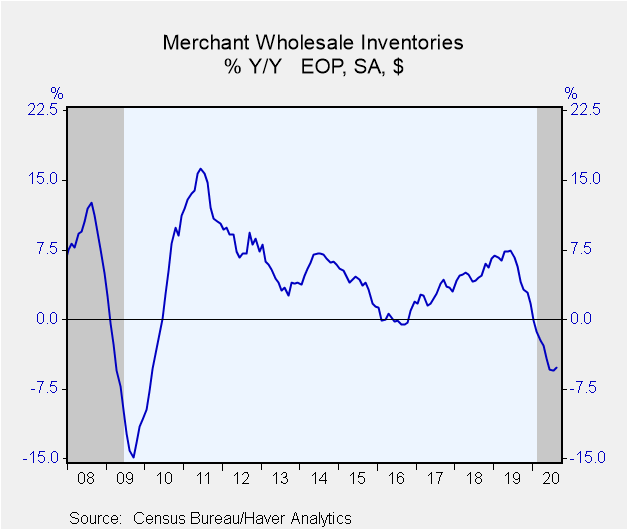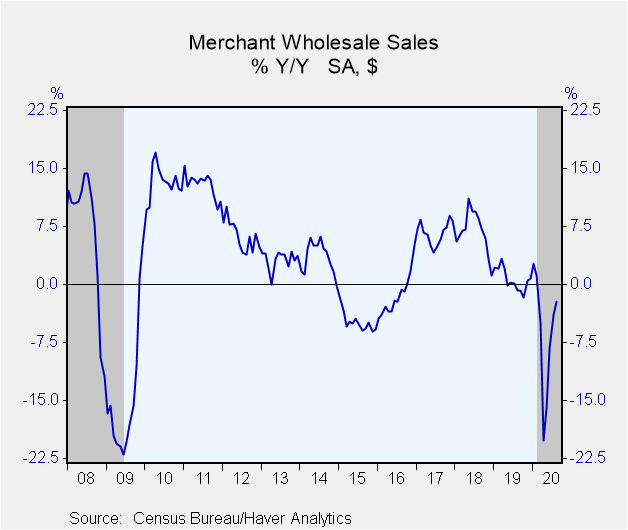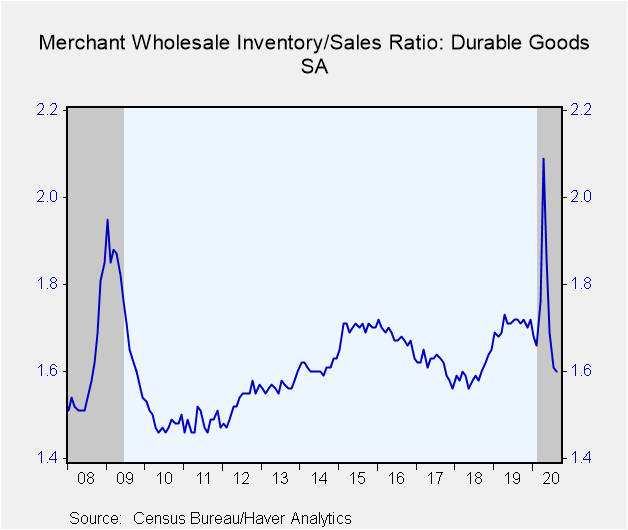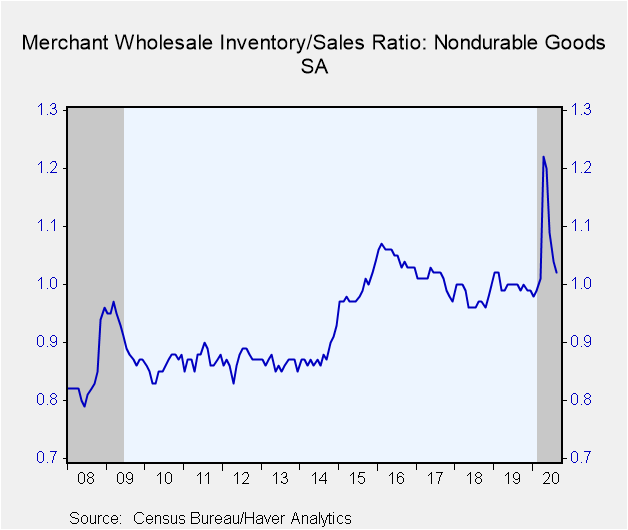 Global| Oct 09 2020
Global| Oct 09 2020U.S. Wholesale Inventories Move Higher in August While Sales Surge
by:Tom Moeller
|in:Economy in Brief
Summary
• Wholesale inventory gain follows three straight months of decline. • Sales continue on upward path for fourth consecutive month. • Inventory-to-sales ratio falls again. Wholesale inventories increased 0.4% during August (-5.2% y/y) [...]
• Wholesale inventory gain follows three straight months of decline.
• Sales continue on upward path for fourth consecutive month.
• Inventory-to-sales ratio falls again.
Wholesale inventories increased 0.4% during August (-5.2% y/y) after a 0.2% July easing, revised from -0.3%. Inventories declined 1.3% and 1.2% in June and in May. A 0.5% August increase had been expected in the Informa Global Markets Survey. Durable goods inventories rose 0.6% (-6.8% y/y), led by a 4.3% jump (-7.8% y/y) in motor vehicle & parts inventories, following a 1.0% July gain. Inventories of lumber & other construction products rose 1.8% (-3.4% y/y), up for the third straight month as home building improved. Stronger housing activity also raised inventories of hardware, plumbing & heating products by 1.1% (-2.0% y/y). Elsewhere, inventories were mixed. Electrical & electronic product inventories rose 0.2% (-3.4% y/y), up moderately for the fourth straight month. Falling, however, were furniture & home furnishing inventories which declined 2.0% (-17.2% y/y), down for twelve straight months. Professional & commercial equipment inventories eased 0.8% (-5.5% y/y) as computer inventories dropped 1.9% (-11.9% y/y). Nondurable goods inventories held steady (-2.5% y/y) as apparel inventories fell 3.0% (-11.6% y/y), off sharply for three straight months. Grocery inventories decreased 1.1% (+1.8% y/y) after three months of increase. Offsetting these declines, paper product inventories rose 1.2% (4.8% y/y) while chemical inventories strengthened 1.8% (-6.1% y/y). The value of petroleum inventories rose 0.1% (-12.5% y/y).
Wholesale sales continued to strengthen in August, up 1.4% (-2.3% y/y) following a 4.8% jump, revised from 4.6%. It was the smallest of four consecutive monthly increases. The Action Economics Forecast Survey anticipated a 1.0% rise. Durable goods sales increased 1.3% (0.3% y/y) as auto sales increased 1.7% (-2.3% y/y) to the highest level in six months. Lumber sales strengthened 3.1% (5.9% y/y), strong for the fourth straight month. Professional and commercial equipment sales rose 2.3% (5.2% y/y) after three months of even stronger increase. Machinery sales rose 2.1% (0.8% y/y). Offsetting these increases was a 1.3% decline (+9.6% y/y) in hardware & home product sales. Electrical equipment sales fell 0.7% (-1.1% y/y) following three months of strong gain. Nondurable wholesale sales gained 1.6% (-4.6%) as purchases of petroleum products strengthened 2.2% (-28.9% y/y). Apparel sales rose 0.5% (-16.5% y/y) but chemical sales declined 4.1% (-14.9% y/y).
The inventory-to-sales (I/S) ratio at the wholesale level slipped to 1.31 in August from 1.32 in July, below a record 1.63 in April (data date back to 1980). The durable goods I/S ratio fell to 1.60, below the high of 2.09 in April. It reflected widespread declines across industries. The nondurable I/S ratio also fell sharply to 1.02 and also reflected widespread industry declines.
The wholesale trade figures and oil prices are available in Haver's USECON database. The expectations figure for inventories is contained in the MMSAMER database. Expectations for sales are in the AS1REPNA database.
The Pandemic, Automation, and Artificial Intelligence from Patrick T. Harker, President & CEO, Federal Reserve Bank of Philadelphia is available here.
| Wholesale Sector - NAICS Classification (%) | Aug | Jul | Jun | Aug Y/Y | 2019 | 2018 | 2017 |
|---|---|---|---|---|---|---|---|
| Inventories | 0.4 | -0.2 | -1.3 | -5.2 | 1.7 | 6.5 | 3.0 |
| Sales | 1.4 | 4.8 | 9.0 | -2.3 | 0.6 | 6.8 | 6.7 |
| I/S Ratio | 1.31 | 1.32 | 1.38 | 1.35 (Aug. '19) | 1.34 | 1.28 | 1.30 |
Tom Moeller
AuthorMore in Author Profile »Prior to joining Haver Analytics in 2000, Mr. Moeller worked as the Economist at Chancellor Capital Management from 1985 to 1999. There, he developed comprehensive economic forecasts and interpreted economic data for equity and fixed income portfolio managers. Also at Chancellor, Mr. Moeller worked as an equity analyst and was responsible for researching and rating companies in the economically sensitive automobile and housing industries for investment in Chancellor’s equity portfolio. Prior to joining Chancellor, Mr. Moeller was an Economist at Citibank from 1979 to 1984. He also analyzed pricing behavior in the metals industry for the Council on Wage and Price Stability in Washington, D.C. In 1999, Mr. Moeller received the award for most accurate forecast from the Forecasters' Club of New York. From 1990 to 1992 he was President of the New York Association for Business Economists. Mr. Moeller earned an M.B.A. in Finance from Fordham University, where he graduated in 1987. He holds a Bachelor of Arts in Economics from George Washington University.










